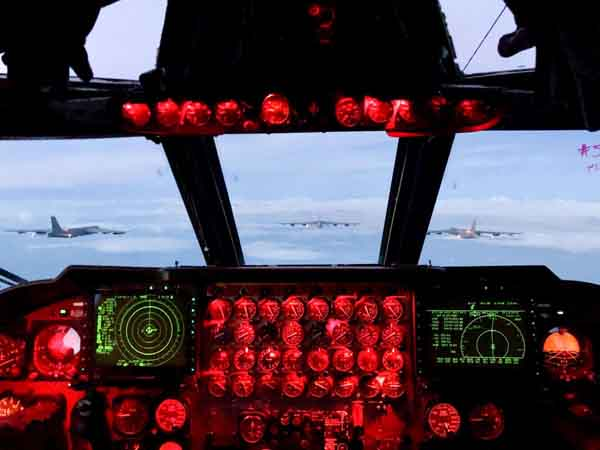
The mission “was designed to underscore the US military’s commitment to its regional partners,” said US Central Command commander General Frank McKenzie.
The United States deployed two B-52 long-range bombers over the Gulf on Thursday in a show of force directed at Iran as Washington moves to cut its ground-level military presence in the region.
The two bombers took off at short notice from Barksdale Air Force Base in Louisiana for the non-stop, 36-hour mission to cross Europe and then the Arabian Peninsula to the Gulf, looping near Qatar while keeping a “safe distance” from Iran’s coastline, US defence officials said.
The mission, the second such in two months, “was designed to underscore the US military’s commitment to its regional partners, while also validating the ability to rapidly deploy combat power anywhere in the world,” according to US Central Command commander General Frank McKenzie.
While McKenzie did not name Iran as the focus of the mission, the US has used shows of force in the air and on the sea to deter Tehran from “malign behavior” toward US forces and allies in the Gulf.
“Potential adversaries should understand that no nation on earth is more ready and capable of rapidly deploying additional combat power in the face of any aggression,” McKenzie said in a statement.
The flight was coordinated with US allies, and aircraft from Saudi Arabia, Bahrain and Qatar flew with the bombers as they traversed the airspace, according to a US defence official.
— US concerns —
A senior military official, who spoke to a small group of reporters on the condition of anonymity to provide details of the mission, said the administration believes that the risk of an Iranian attack on US or allied interests in the region is a bit higher than normal now, and the Pentagon wants to ensure that Tehran thinks twice before doing anything. Adding to the concerns is the presidential transition in the US following Joe Biden’s November victory over Trump. The official said Iran or other adversaries often believe the US may be weaker or slower to respond during a political transition, which American officials flatly deny.
In the last year President Donald Trump has ordered the Pentagon to slash US troop numbers in Iraq to just 2,500 by mid-January, the lowest level since 2003.
Likewise, he is cutting the number of troops on the ground in Afghanistan and Somalia.
But the US Navy has kept a significant presence in the region.
In late November a carrier group led by the nuclear-powered USS Nimitz sailed into the Gulf.
Speaking at a virtual conference sponsored by Defense One after the announcement, McKenzie pointed out that the B-52 deployment came nearly one year after US forces killed Iranian Quds Force commander Qassem Soleimani while he was visiting Baghdad on January 3, 2020.
Since then Iran has been expected to try to retaliate, and even more so since the assassination inside Iran of senior nuclear scientist Mohsen Fakhrizadeh last month, which Tehran blames on Israel.
“I think they were embarrassed by it,” he said of Fakhrizadeh’s murder.
“I think they’re searching for a way to respond… But their process is often slow and often not completely synchronised. So I think they are still working what that’s going to be.”
McKenzie said he is always in discussions with Pentagon leadership on what kind and size of presence the US military needs to deter Iran.
“Because that is our intent: to convince them that it is not in their interest to lash out, it is not in their interest to attack us either directly or indirectly,” he said.
 Eurasia Press & News
Eurasia Press & News

